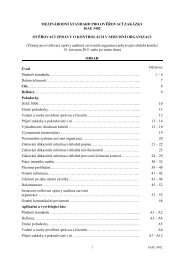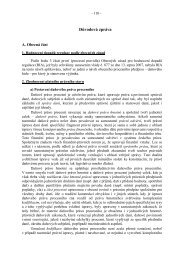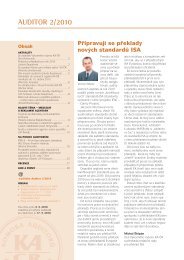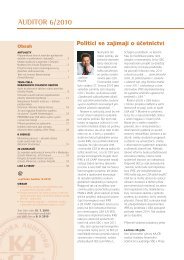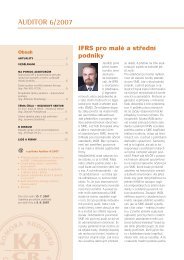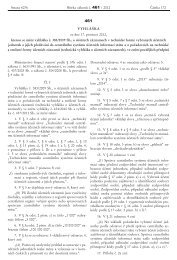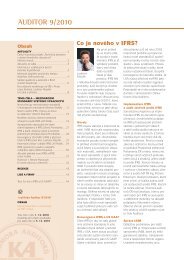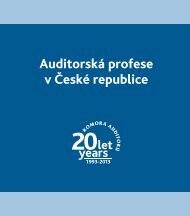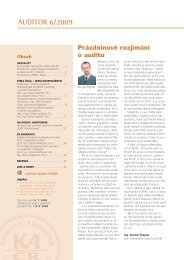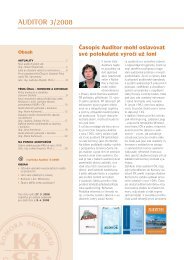Guide to Using International Standards on Auditing in - IFAC
Guide to Using International Standards on Auditing in - IFAC
Guide to Using International Standards on Auditing in - IFAC
You also want an ePaper? Increase the reach of your titles
YUMPU automatically turns print PDFs into web optimized ePapers that Google loves.
86<br />
<str<strong>on</strong>g>Guide</str<strong>on</strong>g> <str<strong>on</strong>g>to</str<strong>on</strong>g> <str<strong>on</strong>g>Us<strong>in</strong>g</str<strong>on</strong>g> <str<strong>on</strong>g>Internati<strong>on</strong>al</str<strong>on</strong>g> <str<strong>on</strong>g>Standards</str<strong>on</strong>g> <strong>on</strong> <strong>Audit<strong>in</strong>g</strong> <strong>in</strong> the Audits of Small- and Medium-Sized Entities Volume 1—Core C<strong>on</strong>cepts<br />
The resp<strong>on</strong>sibility of the audi<str<strong>on</strong>g>to</str<strong>on</strong>g>r is <str<strong>on</strong>g>to</str<strong>on</strong>g> reduce <str<strong>on</strong>g>to</str<strong>on</strong>g> an appropriately low level the probability that the aggregate of<br />
uncorrected and undetected misstatements <strong>in</strong> the f<strong>in</strong>ancial statements exceeds the materiality for the f<strong>in</strong>ancial<br />
statements as a whole. If the audi<str<strong>on</strong>g>to</str<strong>on</strong>g>r simply planned <str<strong>on</strong>g>to</str<strong>on</strong>g> perform audit procedures that would identify <strong>in</strong>dividual<br />
misstatements exceed<strong>in</strong>g 10,000Є, there is a risk that the aggregate of <strong>in</strong>dividually immaterial misstatements<br />
not identified dur<strong>in</strong>g the audit would result <strong>in</strong> the 10,000Є materiality threshold be<strong>in</strong>g exceeded. So the audi<str<strong>on</strong>g>to</str<strong>on</strong>g>r<br />
needs <str<strong>on</strong>g>to</str<strong>on</strong>g> perform some additi<strong>on</strong>al work that is sufficient <str<strong>on</strong>g>to</str<strong>on</strong>g> allow for a marg<strong>in</strong> or buffer for possible undetected<br />
misstatements. The purpose of performance materiality is <str<strong>on</strong>g>to</str<strong>on</strong>g> provide such a buffer.<br />
Performance materiality enables the audi<str<strong>on</strong>g>to</str<strong>on</strong>g>r <str<strong>on</strong>g>to</str<strong>on</strong>g> establish materiality amounts (based up<strong>on</strong>, but lower than,<br />
overall materiality) that reflect the risk assessments for the various f<strong>in</strong>ancial statement areas. These lower<br />
amounts provide a safety buffer between the materiality (performance materiality) used for determ<strong>in</strong><strong>in</strong>g the<br />
nature and extent of audit procedures <str<strong>on</strong>g>to</str<strong>on</strong>g> be performed and the overall materiality.<br />
In the example above, the audi<str<strong>on</strong>g>to</str<strong>on</strong>g>r us<strong>in</strong>g professi<strong>on</strong>al judgment may decide that a performance materiality of<br />
6,000Є would be used <strong>in</strong> design<strong>in</strong>g the extent of the audit procedures <str<strong>on</strong>g>to</str<strong>on</strong>g> be performed. The buffer of 4,000Є<br />
(10,000Є - 6,000Є) between performance materiality and overall materiality provides a safety marg<strong>in</strong> for any<br />
undetected misstatements that may exist.<br />
7.2 F<strong>in</strong>ancial Statement Users<br />
Materiality is used <strong>in</strong> both prepar<strong>in</strong>g and audit<strong>in</strong>g the f<strong>in</strong>ancial statements. Materiality for the f<strong>in</strong>ancial<br />
statements as a whole (overall materiality) is often expla<strong>in</strong>ed (such as <strong>in</strong> f<strong>in</strong>ancial report<strong>in</strong>g frameworks) <strong>in</strong> the<br />
terms such as below.<br />
Exhibit 7.2-1<br />
Influence <strong>on</strong><br />
Mak<strong>in</strong>g Ec<strong>on</strong>omic<br />
Decisi<strong>on</strong>s<br />
Surround<strong>in</strong>g<br />
Circumstances<br />
Comm<strong>on</strong> Needs<br />
of Users<br />
Misstatements, <strong>in</strong>clud<strong>in</strong>g omissi<strong>on</strong>s, are c<strong>on</strong>sidered <str<strong>on</strong>g>to</str<strong>on</strong>g> be material if they, <strong>in</strong>dividually<br />
or <strong>in</strong> the aggregate, could reas<strong>on</strong>ably be expected <str<strong>on</strong>g>to</str<strong>on</strong>g> <strong>in</strong>fluence the ec<strong>on</strong>omic<br />
decisi<strong>on</strong>s of users taken <strong>on</strong> the basis of the f<strong>in</strong>ancial statements.<br />
Judgments about materiality are made <strong>in</strong> light of surround<strong>in</strong>g circumstances, and are<br />
affected by the size or nature of a misstatement or a comb<strong>in</strong>ati<strong>on</strong> of both.<br />
Judgments about matters that are material <str<strong>on</strong>g>to</str<strong>on</strong>g> users of the f<strong>in</strong>ancial statements are<br />
based <strong>on</strong> a c<strong>on</strong>siderati<strong>on</strong> of the comm<strong>on</strong> f<strong>in</strong>ancial <strong>in</strong>formati<strong>on</strong> needs of users as a<br />
group. The possible effect of misstatements <strong>on</strong> specific <strong>in</strong>dividual users, whose needs<br />
may vary widely, is not c<strong>on</strong>sidered.<br />
The audi<str<strong>on</strong>g>to</str<strong>on</strong>g>r determ<strong>in</strong>es materiality based <strong>on</strong> his/her percepti<strong>on</strong> of the needs of users. In apply<strong>in</strong>g his/her<br />
professi<strong>on</strong>al judgment, it is reas<strong>on</strong>able for the audi<str<strong>on</strong>g>to</str<strong>on</strong>g>r <str<strong>on</strong>g>to</str<strong>on</strong>g> assume that users of the f<strong>in</strong>ancial statements:<br />
• Have a reas<strong>on</strong>able knowledge of bus<strong>in</strong>ess, ec<strong>on</strong>omic activities, and account<strong>in</strong>g, and have a will<strong>in</strong>gness<br />
<str<strong>on</strong>g>to</str<strong>on</strong>g> study the <strong>in</strong>formati<strong>on</strong> <strong>in</strong> the f<strong>in</strong>ancial statements with reas<strong>on</strong>able diligence;<br />
• Understand that f<strong>in</strong>ancial statements are prepared and audited <str<strong>on</strong>g>to</str<strong>on</strong>g> levels of materiality;<br />
• Recognize the uncerta<strong>in</strong>ties <strong>in</strong>herent <strong>in</strong> the measurement of amounts based <strong>on</strong> the use of estimates,<br />
judgment, and the c<strong>on</strong>siderati<strong>on</strong> of future events; and<br />
• Make reas<strong>on</strong>able ec<strong>on</strong>omic decisi<strong>on</strong>s <strong>on</strong> the basis of the <strong>in</strong>formati<strong>on</strong> <strong>in</strong> the f<strong>in</strong>ancial statements.




